- Energy Testing
- Insulation
- Windows
- Radon Mitigation
- Energy Solutions
- Attic Air Sealing
- Attic Insulation
- Attic Ventilation
- Rim Joists: Insulation and Air Sealing
- Rooms above garages
- Sidewalls (Open & Closed Cavities)
- Sloped & Vaulted Ceilings
- Bathroom Exhaust Fans
- Basement Walls
- Story-and-a-half Homes: Cape Cod, Salt Box, Modified A-Frame, Bungalow
- Crawlspace Moisture Control & Insulation
- Insulation Cantilevered floors
- Ice Dams
- Rebates & Incentives
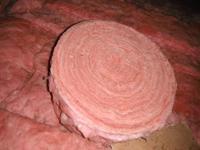
Insulation is wonderful stuff, but it can’t fight heat loss and high energy bills on its own. As much as one third of the energy loss in the home escapes through various gaps, cracks, penetrations and bypasses in the structure of your house. Even with insulation materials like fiberglass laid out over these leakage areas, indoor air makes it way out through the fluffy, porous material (often leaving dust behind much like dusty air moving through a furnace filter).
You can feel and even see some of the air leakage spots around the house, but much of it is built into the very structure. This makes the majority of problem spots nearly impossible to pinpoint with normal observation; these unidentified spots end up costing you, both in energy bills and in compromised home comfort.
You can’t solve these leakage problems by just piling on more insulation. In fact, burying the leaky areas in more insulation often does more harm than good (trapping moisture, restricting ventilation, etc). The true cure to the problem is targeted, professional air sealing for your Twin Cities Metro Area home.
Where Are The Leaks?
Let’s start from the most visible to the least visible sources of air leaks in a typical attic:
Attic Access Hatch: The Biggest Loser
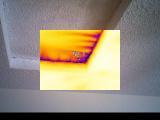
Picture cracking open a bedroom window about an eighth of an inch. Then picture leaving it open all through the glacial Minnesota/Wisconsin Winter. Can you imagine how much heat you’d lose and how much energy you’d waste?! Frighteningly enough, that’s about the amount of air that leaks (or more accurately - pours) out of your attic access hatch in the heating season.
We seal these notorious leakage points with thick, polypropylene weatherstripping, and cinch them down tight with eye-hook or bolt-style latches. We’re thorough about our work, so to ensure that the insulation on top of the hatch stays put, SCES also builds up and secures several layers of rigid foam board insulation on top of the hatch, eliminating this nasty weak point.
Chimney, Flue and Duct Chases
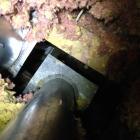
Flues for chimneys, furnaces, and water heaters are often installed in oversized chases that run from the basement to the attic. Without proper sealing, these spacious chases are a wide open highway for heat loss. Our team takes special care to use fireproof and fire-retardant material when sealing around these heat sources. We use sheet metal, high-temperature silicone caulking, and fire-proof mineral wool insulation to close energy-sucking leaks and provide a barrier between the heat source and existing insulation.
Recessed Lights
Recessed light fixtures affect your home in a couple of important ways:
First, the incandescent bulbs in the fixtures are very inefficient, and give off a lot of heat (over 300º of “easy bake oven” power that warms up the attic and can exacerbate ice dams).
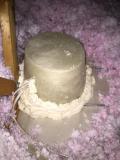
Recessed light fixtures also allow conditioned indoor air to escape, since the metal “coffee can” fixture protrudes into the attic and is riddled with holes. The drywall penetration covered by the light’s trim ring is often roughly cut as well, leaving a wide gap and an easy escape route for conditioned indoor air.
Our SCES team seals these fixtures by capping them from the attic with an insulated cover that blocks air leakage. We also seal the fixture from below with silicone caulking, which virtually eliminates air leakage. As an additional option, we can help you replace the bulbs with LED equivalents that will save you at least 80% of the electricity used for incandescent bulbs.
Dropped Soffits
Soffits, or dropped ceilings, are often used above kitchen and bathroom cabinets or along the ceilings of rooms and hallways. Aside from some architectural flair, soffits are also house ductwork or chases. Often, these areas are unsealed and are major culprits for energy loss, and are wide open to the attic above, creating an easy pathway for conditioned air to escape.
Worse yet, they often contain recessed lights and all of the leakage associated with them. Sealing these soffits from the attic and capping them with rigid materials like OSB (oriented strand board), drywall, or foam board eliminates the leakage--and keeps cupboards and their contents at room temperature!
Plumbing, Electrical, Lighting and Fan Penetrations
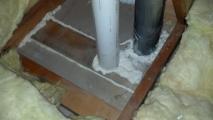
There are many small penetrations in the home around electrical wiring, fan ventilation, and plumbing pipes. Every wire, pipe, and electric box that breaks through the finished ceiling is a pathway for heat loss. Though each penetration is small, the cumulative energy and air loss for the home is significant. Our team is attentive to these small areas and uses caulking or foam sealant to make sure they are tightly sealed. Closing up these penetrations with a bit of caulking or foam not only tightens up the home, it also helps prevent the spread of flames in the event of a fire.
Top Plate Penetrations
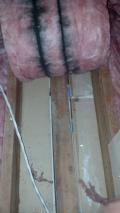
Though the gap between the drywall of a ceiling and the 2x4 framing of interior partition walls may be only an eighth- or sixteenth- of an inch wide, there are hundreds of linear feet of this gap throughout the home. Taken together, they add up to serious air loss. As we follow top plates along in pursuit of other, bigger leaks, we foam seal this connection as we go to minimize leakage. And sometimes (as the image at left suggests) top plate leakage is not so minimal! 10 short years of leaking air (and the dust that came with it) were enough to create nasty "racing stripes" in this batt insulation! Don't worry - we've sealed it up!
St. Croix Energy Solutions offers air sealing services to ensure that your attic is tight and efficient. Our team is here to make sure your insulation is properly supported with air sealing.
If you have concerns about air loss in your attic, get in touch with us to learn more about identifying the sources and stopping the issue.
Contact UsEnergy Assessments for $450 or less
Schedule your FREE Home Estimate
Testimonials
Linda M., Baldwin, WI
Do you hate sitting on a cold toilet seat at 2 A.M.? Hate walking across frosty floors when Fido needs go out at 3 A.M.? Hate those dollar stealing heating bills? Well. Use that negative energy to your advantage.....run, don't walk to your laptop and Google St. Croix Energy Solutions. Be prepared to meet the nicest and efficient installers you could ever hope to meet. Then sit back and wait for the mailman to deliver that next heating bill....you will be more than pleasantly surprised. Thankyou, to the entire sales force and installation crew for a wonderful job!
